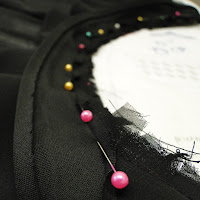The Peter Pan Blouse by Simple Sew is quite 60s in design, with its cute collar and its loose fitting, baby-dollesque shape. It's the perfect sewing pattern for floaty summery fabrics. My choice was this lovely georgette from FC FABRIC STUDIO. Although it's a plain block colour I knew its see-through factor could add a bit of interest!
I've worked with floaty fabrics before so knew the terror I could be letting myself in for. Experience makes for knowledge though so this time I was better prepared.
Accurate cutting out is pretty essential. The blouse is literally made up of three main pieces-a front and two back halves which fasten up with buttons and a collar. With no pattern to match this session (thank lord), I cut everything on the fold. Once I'd matched up my selvedges on my lovely kitchen floor, I weighed this down with pattern weights (okay fine, sardine cans) then weighed down my pattern pieces instead of pinning so as not to disrupt my fabric.
Using rotary cutter stops the bottom layer of fabric from sliding around when you cut as it would do if you were cutting with shears, making for more accurate pieces. Yay.
I cut the collar from a scrap of fake suede I had in attempt to add a bit more excitement, but found the two different shades of black didn't sit well together at all. Instead I cut the collar from some remainder georgette and cut another pair to use inside as a facing to add a little more strength. Due to the sheer qualities of the fabric I didn't want to use an iron on interfacing in case you could see it from the right side.
 |  |  |
I cut my three pairs of collar only to find they didn't match up in the slightest! Damn slippy and slidey fabric, so frustrating! Time to call out the big guns like I should have done from the start! My secret weapon was a can of spray starch. It was the first time I'd had a go and I can tell you it worked wonders! So for any other starch virgins, the drill is you spray your fabric, press it so it dries and then hey presto, your fabric is 1000000x more stable and so much easier to work with! When you're all stitched up, give your garment a wash and your fabric will return to its glorious drapey self.
So I tacked in my middle layer of collar then stitched the two collar pieces and turned right side out. They have to be spot on symmetrical otherwise it's painfully obvious when you attach the two pieces to your neckline! I won't lie to you, I had to make a few tweaks to them both to get them to match.
I gave my side seams and shoulder seams a quick blast with starch to help stabilise before stitching.
The collar insertion is then hidden with a strip of bias binding. I got enough fabric with it in mind that I would make my own, but the prospect seemed too much faff when I saw the pre-made rolls on the stall in the market. I still need to work on neat finishes at the end of my binding. Any tips anywhere?
The back opening is made by folding over about 2cm on either side to make way for buttons and button holes. The pattern says nothing about facing this but I strongly suggest it, especially if you are using a lightweight fabric. Again I cut an extra piece of my georgette and tacked this in for extra stability. You then fold the centre back under itself and stitch down on either side to create a nice neat placket, about 2cm wide.
 |  |  |
I was so pleased I finally had a project worth buying these beautiful buttons for! I've been eyeing these lovelies up since I started sewing. Aren't they just gorgeous! The pattern features 6 buttons down the centre back, about 10cm apart.
Everyone hates doing button holes, but this time it ran quite smoothly! Stitching on the buttons to correlate always frustrates me a bit too! I found getting them in the exact position really tricky. With them being on the back it was hard to check out how I was getting on!
With all the buttons sewn on I found the back gaped between the top two. SO frustrating! With such a wide button placement though this was bound to happen. I would suggest using smaller buttons closer together. Instead I used a sneaky popper in between the top two buttons that seems to do the trick.
A quick hem to finish and we were all done!
x
Location: Weston Park, Sheffield
Currently listening to: Josefin Öhrn + The Liberation, Dunes





















